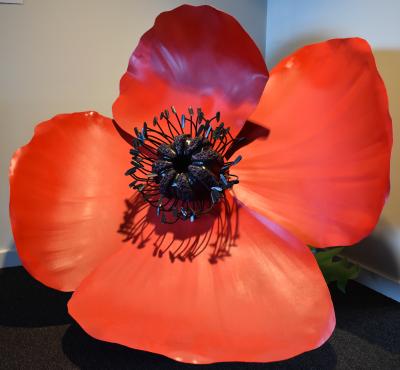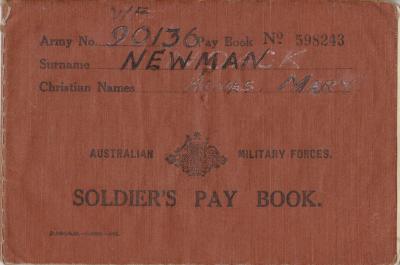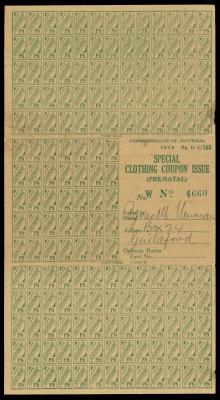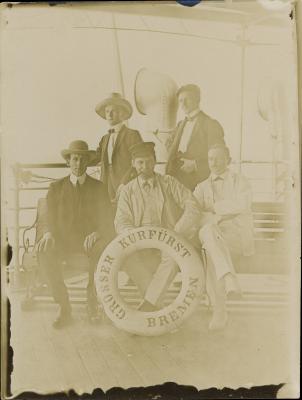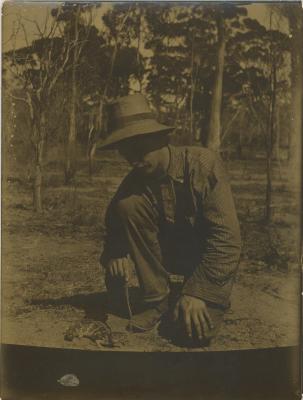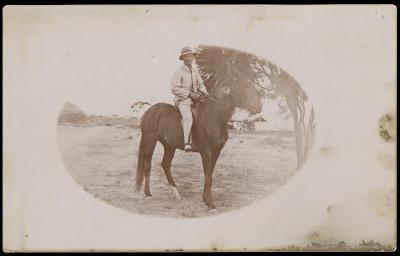First World War German Mauser M1898/05 Bayonet with Scabbard
c. 1916A German M1898/05 bayonet and scabbard. The bayonet features a metal hooked quillon. The blade is a single edged spear point design. Grips are formed by two-pieces of wood, retained by two plain-headed bolts with slotted nuts and adorned with nine diagonal grooves. The back of the grip is flat and straight while the underside is rounded and well-shaped to hand. A sheet steel flashguard has been attached to the hilt back. The metal pommel meets the wooden grips in a double curve and shows an attachment slot. The pommel shows signs of rust as does the metal quillon. The blade is in very good condition. The flat base of the ricasso is stamped with cross keys above the manufacturers name. The blade spine shows vertically a crown, then underneath a gothic L, then 16 and finally a crown over W (for Wilhelm II) The quillon displays numbers 723. The scabbard is of all metal construction with a rimmed mouthpiece secured by a single screw through the front. There is a small flat tapered oval frog stud adorned with two indented horizontal lines on its stem and the frog has an oval base. The body of the scabbard tapers gently for most of its length and then more sharply. The scabbard is showing significant rust pitting on one side.
The M1898/05 Seitengewehr bayonet with scabbard was designed to fit the Gewehr 98 bolt-action rifle made by Mauser; the standard infantry rifle of the German army during the First World War. The M1898/05 was a common German bayonet of the First World War and also known as the “Butcher”. This is a fine example made by “Fichtel & Sachs Schweinfurt” and stamp dated 1916 with a scarce Bavarian Crowned marking.
Every combat rifle was designed to use the bayonet as weapon of last resort and the Gewehr 98 had a top barrel clip with a 45mm long bayonet lug. The rifle was originally issued with the Seitengewehr 98 type bayonet, a 500mm long quillback blade. This bayonet was found to be too long for trench close combat and so by the end of the war it was replaced with a 254mm Seitengewehr 84/98 blade.
In addition, at the beginning of the war it was found that this model of bayonet had a problem when used with the Karabiner 98 rifle, the shorter barrel on this model led to burning and damage to the grips as the barrel stopped short of the vestigial muzzle ring. Therefore in 1915, it was decided to fit a steel flash guard (Schutzbleche) to the back of the hilt to protect the grips. The bayonet was modified by removing most of the remaining muzzle ring, reducing the back of the tang, and adding the flash guard. Additionally, an all-steel scabbard was introduced to replace the more easily damaged leather.
This bayonet was manufactured by Fichtel and Sachs in Schweinfurt. The firm was founded in 1895 as precision ball bearing plant, but is considered as a pioneer and forerunner of the bicycle boom. During the four years of war, in addition to hubs and ball bearings of all kinds, armament products were manufactured in Schweinfurt.
The bayonet was brought back to Australia from the First World War by Private Holland and represents an example of soldiers returning home bringing enemies weapons as a ‘keep-sake’ of their war service from the Western Front
Details
Details
Ricasso: “FICHTEL & SACHS / SCHWEINFURT”
Open in Google Maps
Nearest geotagged records:
- Invalid Cup (0km away)
- Peter Loney Letter (0km away)
- Ellis SILAS Water Colour Painting (0km away)
- Engraved Japanese Water Bottle belonging to Robert George Staunton RENNIE WX7493 (0km away)
- Enlistment Poster (0km away)
- W. D. & H. O. Wills Lace Flag Cigarette Cards (0km away)
- First world War Picture Postcard (0km away)
- Photograph of the Japanese surrender to Australia on 13 September 1945. (0km away)
- Engraved Tin given to Major Arthur Robinson HOME WX11151 (0km away)
- Martini-Henry action (0km away)
Nearby places: View all geotagged records »
Princess Royal Fortress Military Museum
Princess Royal Fortress Military Museum
Other items from Princess Royal Fortress Military Museum
- Carved Stick from Holly Ridge, Gallipoli as gathered by Lt-Col. Rupert Anstice RAFFERTY
- 1915 Metal Whistle issued to Lt-Col. Rupert Anstice RAFFERTY
- First World War Memorial Plaque for Ernest Charles Gordon SCOTT
- In the sands of our remembrance, grows the soul of our nation (Poppy sculpture)
- Picture in frame “FLEET WEEK AT ALBANY”
- Black leather bound Holy Bible presented to Reverend Ivern A. JACOBS
- Quarterly Ticket of Membership to Methodist Church of Australasia – Rev. Ivern A. JACOBS
- Soldier’s Pay Book Issued to Agnes Mary NEWMAN, WF90136 & Pouch
- Commonwealth of Australia 1948 “Special Clothing Coupon Issue (Pre-Natal)"
- Black & White Photograph of William Charles NOACK and four men
- Black & White Photograph of William Charles NOACK
- Black & White Photographic Postcard of William Charles NOACK on Horseback
Scan this QR code to open this page on your phone ->


